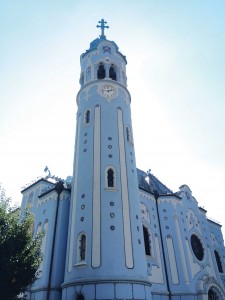Lenin, Lennon, and Comăneci
A journey down the Danube River
In the early 1970s, in order to complete the Iron Gate Dams and harness the awesome power of the Danube River for hydroelectricity, the ancient town of Orșova, Romania, was flooded. All residents had to be moved while every building in the town was rebuilt on higher ground, notably a Catholic cathedral, despite the communists’ not-so-subtle objections to organized religion. A local artist was commissioned to paint the stations of the cross inside the new church, and into these iconic scenes he surreptitiously inserted three modern figures: Vladimir Lenin is among the condemners of Jesus; famed Romanian gymnast Nadia Comăneci joins the women mourning Jesus’ death on the cross; and in the final scene, behind the risen Christ, stands John Lennon, singing, presumably, of redemption.
 This act of political subversion epitomizes some of the preeminent themes one discovers while traveling down the historic Danube River, as 36 Flying Longhorns did this September, through the heart of Eastern Europe: politics, religion, and national pride. From the Czech Republic to Bulgaria, countries formerly behind the Iron Curtain are grappling with the conversion to capitalist democracies. Over two weeks, the group visited eight countries, exchanged five currencies, sampled local delicacies like Viennese Sacher torte and Hungarian goulash, and saw countless churches. Eight of the 14 nights were spent on the Amadeus Brilliant, an aptly-named vessel with all the amenities of a modern hotel, save reliable Wifi.
This act of political subversion epitomizes some of the preeminent themes one discovers while traveling down the historic Danube River, as 36 Flying Longhorns did this September, through the heart of Eastern Europe: politics, religion, and national pride. From the Czech Republic to Bulgaria, countries formerly behind the Iron Curtain are grappling with the conversion to capitalist democracies. Over two weeks, the group visited eight countries, exchanged five currencies, sampled local delicacies like Viennese Sacher torte and Hungarian goulash, and saw countless churches. Eight of the 14 nights were spent on the Amadeus Brilliant, an aptly-named vessel with all the amenities of a modern hotel, save reliable Wifi.
After three nights at the famed Art Deco Imperial Hotel in Prague, the group motored to Passau, Germany, where we boarded the Amadeus at the confluence of the Ilz, Inn, and Danube rivers. The typical itinerary involved sailing overnight, then waking to find the boat docked in some new town, which the group would then tour by day.
“The highlight for me,” says Harrison Stafford, BBA ’63, LLB ’66, Life Member, “was the nighttime cruise out of Budapest. With so many lights on both sides of the river, it reminded me what an international city it is. It’s something everyone needs to see.”
In Vienna, the group toured the royal condominiums inside the palace and was introduced to the famed Hapsburgs, the family that ruled the Austro-Hungarian empire for centuries until Archduke Franz Ferdinand was assassinated, setting off World War I. At the time, the Hungarians were building a magnificent Parliament building right on the banks of the Danube. By the time it was completed, the war was over, and the Hungarian empire was proscribed. Today, the mighty, Gothic-style Parliament building stands as shining reminder of Hungary’s former self. As the local guide twice reminded the group, a common Hungarian saying goes: “We are the only country surrounded by itself.”
 The final leg of the trip through former Yugoslavia took us past bombed-out buildings in Belgrade, Serbia, an eerie reminder of the Balkans’ volatile political history. We finished our tour in beautiful Sofia, Bulgaria, a shining metropolis comfortable in its new, capitalist groove. At the last stop on the trip, at the towering Cathedral of St. Alexander of Neva, the most remarkable aspect was not the enormous size or its magnificent golden domes; instead it was a hunchbacked man asking for donations just inside the church doors. The bearded man had been begging on the church steps for decades. It was only recently, though, that church officials learned that for almost the whole time he’d been a beggar he had been passing along the donations to the church itself and had become the number one donor of all its patrons. John Lennon and Jesus Christ could sing a great duet about him.
The final leg of the trip through former Yugoslavia took us past bombed-out buildings in Belgrade, Serbia, an eerie reminder of the Balkans’ volatile political history. We finished our tour in beautiful Sofia, Bulgaria, a shining metropolis comfortable in its new, capitalist groove. At the last stop on the trip, at the towering Cathedral of St. Alexander of Neva, the most remarkable aspect was not the enormous size or its magnificent golden domes; instead it was a hunchbacked man asking for donations just inside the church doors. The bearded man had been begging on the church steps for decades. It was only recently, though, that church officials learned that for almost the whole time he’d been a beggar he had been passing along the donations to the church itself and had become the number one donor of all its patrons. John Lennon and Jesus Christ could sing a great duet about him.
From top: The Hungarian Parliament Building at Night, in Budapest; A portion of the painting that features Lenin, Lennon, and Comăneci; The Church of St. Elizabeth, known as the “Blue Church,” in Bratislava, Slovakia.
Photos by Tim Taliaferro.
